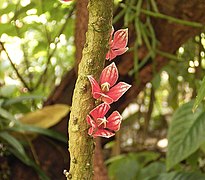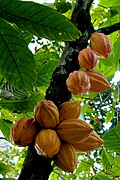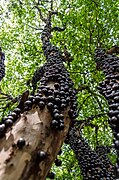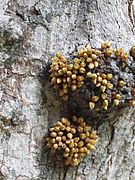Cauliflory
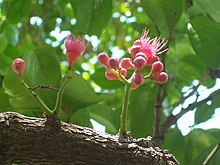

Cauliflory is a botanical term referring to plants that flower and fruit from their main stems or woody trunks, rather than from new growth and shoots.[1] It is rare in temperate regions but common in tropical forests.[2]
There have been several strategies to distinguish among types of cauliflory historically, including the location or age of branch where inflorescences grow,[3] whether inflorescences attach to stolons or branches,[4] and whether axillary nodes or adventitious nodes develop into reproductive tissues.[5] Cauliflory is a non-homologous phenomenon with several different sources of development and evolutionary value.[5]
The development of buds in axillary cauliflorous species occurs through either the re-use of the same position or old tissue over seasons of growth or release from dormancy.[5] In both cases, vascularization of the bud must occur from pre-existing tissue, such as the pith.[6] In Cercis canadensis, dormant buds break annually in a sympodial pattern.[5] If flowers develop adventitiously, they form similarly to epicormic tissues and may be reactive to immediate environmental conditions. In certain species of Ficus, flowers may be produced from axillary buds in young plants and change to adventitious buds later.[7]
One frequently suggested hypothesis for the evolution of cauliflory is to allow trees to be pollinated or have their seeds dispersed by animals, especially bats, that climb on trunks and sturdy limbs to feed on the nectar and fruits.[8] Some species may instead have fruit which drops from the canopy and ripen only after they reach the ground, an alternative strategy termed nonfunctionally caulicarpic fruits.[8] In Ficus, there is not an association between the evolution of cauliflory as an apomorphy and ecological associations.[4] Alternative hypotheses have focused on competition for sugar and minerals between flowers and young leaves,[9] mechanical support for larger flowers and fruits particularly in Atrocarpus and Durio,[10] and evolutionary theory built on the plant as a metapopulation and differential rates of mutations across large plant bodies.[5]
An extreme version is flagelliflory where long, whip-like branches descend from the main trunk and bear all the inflorescences. The branches grow to and along the ground and even below it. As a result, the plant or tree's flowers can appear to emerge from the soil. Examples are known mostly from the plant families Annonaceae and Moraceae such as a species of Desmopsisterriflora but also include Couroupita guianensis (Lecythidaceae) and the cactus Weberocereus tunilla (Cactaceae). [2]
Families, genera and (some) species[edit]
(list incomplete)
- Moraceae
- Ficus: F. racemosa (cluster fig), F. sansibarica (knobby fig), F. sur (Cape fig), F. sycomorus (sycamore fig), F. coronata (sandpaper fig)
- Artocarpus: A. heterophyllus (jackfruit), A. integer (chempedak), A. altilis (breadfruit)
- Myrtaceae
- Syzygium: S. moorei, S. cormiflorum
- Plinia: P. cauliflora[8]
- Myrciaria cauliflora[11] (Jaboticaba/Brazilian Grape Tree)
- Malvaceae
- Theobroma: T. cacao (cacao), T. grandiflorum (cupuaçu)[12] (and possibly others)
- Cola:[13] C. mossambicensis (and possibly others)[13]
- Crescentia: C. cujete (calabash tree).[14]
- Pavonia: P. strictiflora
- Durio[5]
- Fabaceae
- Surianaceae
- Meliaceae
- Dysoxylum spp. including D. parasiticum (ramiflorous)[16] and D.spectabile[17]
- Sapindaceae
- Pancovia:[18] P. golungensis (false soap-berry)[19]
- Chytranthus[5]
- Caricaceae
- Carica papaya (papaya)
- Putranjivaceae
- Drypetes natalensis (Natal ironplum) (and possibly others)[20]
- Sapotaceae
- Englerophytum magalismontanum (stamvrug)
- Omphalocarpum[5]
- Stilbaceae
- Halleria lucida[21] (tree fuchsia)
- Annonaceae
- Uvariopsis (all species are ramiflorous, cauliflorous or both.)[22] Cauliflorous species are: U. submontana.[23] U. sessiflora,[22] U. congolana,[22] U. guineensis,[22] U. vanderystii,[22] U. noldeae,[22] U. doica,[22] U. letestui,[22] U. bakeriana,[22] U. solheidii,[22]
- Polyalthia cauliflora
- Piptostigma[5]
- Annonidium mannii[5]
- Oxalidaceae
- Averrhoa bilimbi (bilimbi)[24]
- Cunoniaceae[25]
- Lecythidaceae
- Couroupita guianensis (cannonball tree)
- Gustavia, Grias, Couroupita[5]
- Thymelaeaceae
- Phaleria clerodendron (scented daphne)
- Bignoniaceae[26]
- Ebenaceae[5]
- Aristolochiaceae
Image gallery[edit]
-
Syzygium moorei fruit
-
Ficus (fig)
-
Coffee Plant (Coffea)
-
Jabuticaba (Plinia cauliflora)
-
Kohekohe (Dysoxylum spectabile)
-
Scented daphne Phaleria clerodendron
See also[edit]
References[edit]
- ^ "PlantNET - NSW Flora Online - Glossary". Retrieved May 17, 2022.
- ^ a b Fernanda Martínez-Velarde, Maria; 6 others, and (2023). "Desmopsisterriflora, an extraordinary new species of Annonaceae with flagelliflory". PhytoKeys (227): 181–198. doi:10.3897/phytokeys.227.102279. PMC 10314296. PMID 37396012.
{{cite journal}}: CS1 maint: numeric names: authors list (link) - ^ Mildbraed, J (1922). wissenschafliche Ergebnisse der Zweiten Deutschen zentral-Afrika-Expedition 1910-1911underFuhrung Adolph Friedrichs. Herzogs zu Meckleburg.
- ^ a b Harrison, Rhett D.; Rønsted, Nina; Xu, Lei; Rasplus, Jean-Yves; Cruaud, Astrid (2012-06-05). "Evolution of Fruit Traits in Ficus Subgenus Sycomorus (Moraceae): To What Extent Do Frugivores Determine Seed Dispersal Mode?". PLOS ONE. 7 (6): e38432. Bibcode:2012PLoSO...738432H. doi:10.1371/journal.pone.0038432. ISSN 1932-6203. PMC 3367955. PMID 22679505.
- ^ a b c d e f g h i j k l m n o Ann., Owens, Shirley. Cercis (Fabaceae) : Evolution of cauliflory in the genus. OCLC 1085986861.
{{cite book}}: CS1 maint: multiple names: authors list (link) - ^ Lent, Roy (1966). The origin of the cauliflorous inflorescence of Theobroma cacao. OCLC 175296194.
- ^ Pundir, YP (1972). "Cauliflory in Ficus Glomerata Roxb". Turrialba.
- ^ a b c van der Pijl, L. (March 1961). "Ecological Aspects of Flower Evolution. II. Zoophilous Flower Classes". Evolution. 15 (1): 44–59. doi:10.2307/2405842. ISSN 0014-3820. JSTOR 2405842.
- ^ Richards, P (1952). The tropical rainforest; an ecological study. Cambridge University Press.
- ^ CORNER, E. J. H. (October 1949). "The Durian Theory or the Origin of the Modern Tree". Annals of Botany. 13 (4): 367–414. doi:10.1093/oxfordjournals.aob.a083225. ISSN 1095-8290.
- ^ Popenoe, Wilson (July 1914). "The Jaboticaba". Journal of Heredity. 5 (7): 318–326. doi:10.1093/oxfordjournals.jhered.a107885.
- ^ Govaerts, R. et al. (2018) "Theobroma cacao L.". Royal Botanic Gardens. Retrieved May 17, 2022.
- ^ a b Govaerts, R. et al. (2018) "Cola Schott & Endl.". Royal Botanic Gardens. Retrieved May 17, 2022.
- ^ "Crescentia cujete". Tropilab. Retrieved May 17, 2022.
- ^ Govaerts, R. et al. (2018) "Cercis siliquastrum L.". Royal Botanic Gardens. Retrieved May 17, 2022.
- ^ "Dysoxylum parasiticum (Osbeck) Kosterm. ". Royal Botanic Gardens. Retrieved May 17, 2022.
- ^ " Dysoxylum spectabile (G.Forst.) Hook.f." NZflora. Retrieved May 17, 2022.
- ^ "Pancovia Willd.". Royal Botanic Gardens. Retrieved May 17, 2022.
- ^ "Pancovia golungensis (Hiern) Exell & Mendonça". Royal Botanic Gardens. Retrieved May 17, 2022.
- ^ Govaerts, R. et al. (2018) "Drypetes Vahl". Royal Botanic Gardens. Retrieved May 17, 2022.
- ^ "Halleria lucida L.". Global Biodiversity Information Facility. Retrieved May 17, 2022. (See images)
- ^ a b c d e f g h i j Gereau, E. R.; Kenfack, D. (2000). "Le genre Uvariopsis(Annonaceae) en Afriquetropicale, avec la description d'une espèce nouvelle du Cameroun" (PDF). Adansonia (in French). 22 (1): 39–43. Retrieved May 17, 2022..
- ^ Cheek, M. (2014) Cheek, M. (2014). "Uvariopsis submontana". IUCN Red List of Threatened Species. 2014: e.T45421A3001680. doi:10.2305/IUCN.UK.2014-3.RLTS.T45421A3001680.en. Retrieved May 17, 2022. doi:10.2305/IUCN.UK.2014-3.RLTS.T45421A3001680.en(See images)
- ^ Ahmed, QamarUddin; Alhassan, AlhassanMuhammad (2016). "Averrhoa bilimbiLinn.: A review of its ethnomedicinal uses, phytochemistry, and pharmacology". Journal of Pharmacy and Bioallied Sciences. 8 (4): 265–271. doi:10.4103/0975-7406.199342. PMC 5314823. PMID 28216948. Retrieved May 17, 2022.
- ^ Moody, Michael; Hufford, Larry (2000-08-01). "Floral development and structure of Davidsonia (Cunoniaceae)". Canadian Journal of Botany. 78 (8): 1034–1043. doi:10.1139/b00-073. ISSN 0008-4026.
- ^ Fonseca, Luiz Henrique M.; Lohmann, Lúcia G. (2017-09-25). "Adenocalymma cauliflorum (Bignonieae, Bignoniaceae), a New Cauliflorous Species from the Atlantic Forest of Eastern Brazil". Systematic Botany. 42 (3): 584–589. doi:10.1600/036364417X696078. ISSN 0363-6445. S2CID 91020529.
- ^ Endress, Peter K. (2010-07-12). "Disentangling confusions in inflorescence morphology: Patterns and diversity of reproductive shoot ramification in angiosperms". Journal of Systematics and Evolution. 48 (4): 225–239. doi:10.1111/j.1759-6831.2010.00087.x. S2CID 83742105.





